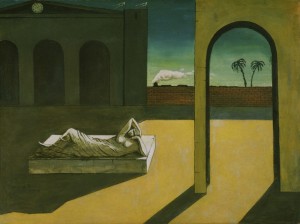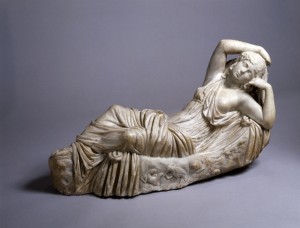 Drawing from its own strength and its own collection, the new show, “Modern Antiquities†at The Getty Villa cannily enters the Pacific Standard Time (PST) conversation as an unofficial “prequel†exhibition, juxtaposing the works of four major twentieth-century artists (mainly on international loan) alongside ancient art (primarily from the permanent collection). Pablo Picasso (1881-1973), Giorgio de Chirico (1888-1978), Fernand Léger (1881-1955), and Francis Picabia (1879-1953) are connected as peers, friends, mentors, and also by the fact that Léonce Rosenberg served as a dealer to each of them, but mainly by the fact that each made important, radical even, contributions to the art movements of their time. Reflecting disparate, but intertwined threads through Surrealism, Dada, Cubism, and Futurism, symbols and echoes from the antique past emerge. All the works are from 1906 to 1936, just prior to the PST time frame of 1945-1980, and in a European context.
Drawing from its own strength and its own collection, the new show, “Modern Antiquities†at The Getty Villa cannily enters the Pacific Standard Time (PST) conversation as an unofficial “prequel†exhibition, juxtaposing the works of four major twentieth-century artists (mainly on international loan) alongside ancient art (primarily from the permanent collection). Pablo Picasso (1881-1973), Giorgio de Chirico (1888-1978), Fernand Léger (1881-1955), and Francis Picabia (1879-1953) are connected as peers, friends, mentors, and also by the fact that Léonce Rosenberg served as a dealer to each of them, but mainly by the fact that each made important, radical even, contributions to the art movements of their time. Reflecting disparate, but intertwined threads through Surrealism, Dada, Cubism, and Futurism, symbols and echoes from the antique past emerge. All the works are from 1906 to 1936, just prior to the PST time frame of 1945-1980, and in a European context.
While hindsight is often touted as being 20/20, it is also susceptible to change; in recent years the influence of Marcel Duchamp on modernity has grown to such proportions that his peers seem antiquated in comparison. But a focused look at a selection of works from Picasso, de Chirico, Léger, and Picabia, in the context of transforming and reinventing antiquity, reveals how deeply these artists were working through not only their own classical instruction, but how they were using these images for leverage into the next idea – perhaps similar to the way American artists often find themselves working through the Minimalism of the 60’s and 70’s.
De Chirco’s engagement with antique imagery is obvious, especially in his well-known oil paintings of deserted Italian piazzas from 1912-13. At the time of these paintings, de Chirico had already moved to Paris and had made the acquaintance of Picasso (and Apollinaire) and was involved in a metaphysical expression of his life and ideas. A recurring motif is a statue of the reclining figure of Ariadne. A real 2nd century marble sculpture of “Sleeping Ariadne†strategically situated near de Chirico’s works gives us pause to think through more about de Chirico’s choice. Much attention has been given to the strange and unsettled quality of his abandoned squares; and to the juxtaposition of anachronistic objects, such as the puffing locomotive and the clock, to the classical architecture. Less attention given to the choice of Ariadne: she who provided Theseus with a ball of red thread to find his way out of the Minotaur’s labyrinth was likely a compelling draw for de Chirico, who insisted on the metaphysical content of his paintings. She is the symbol of the link between deeper internal subconscious meaning and the outside. Claiming the Hellenic figure for his own iconography, does not diminish the strength of de Chirico’s role in portraying surreal dreamscapes.
Indeed, the impetus behind this exhibition seems to be a proving that drawing from antiquity does not imply conservative regression. Rather, as in the Léger’s Nude on a Red Background, 1927, the smooth robust and stylized marble statues of the 1st century, provide merely a substrate, from which highly mechanized robotic beauties are born. In contrast to the previously idealized human form, both Léger and Picabia relished the machine.
Presaging contemporary appropriation, these four artists have a foot in more than one world, and are working through the many new treatises of their time. Not only is the aesthetic impact of classical beauty and history clear in this exhibition, but also the way that the modern interpretation of antique imagery has shaped our contemporary experience of the same. As in all art history, the old is subsumed and digested to make way for the new. So often, modern art is regarded in context of subsequent art, but here is the opportunity to experience modern art in relation to the classical past. The Getty Villa itself is a reconstruction of an ancient Roman house. The exhibition will be accompanied by a catalog by Christopher Green and Jens M. Daehner.

